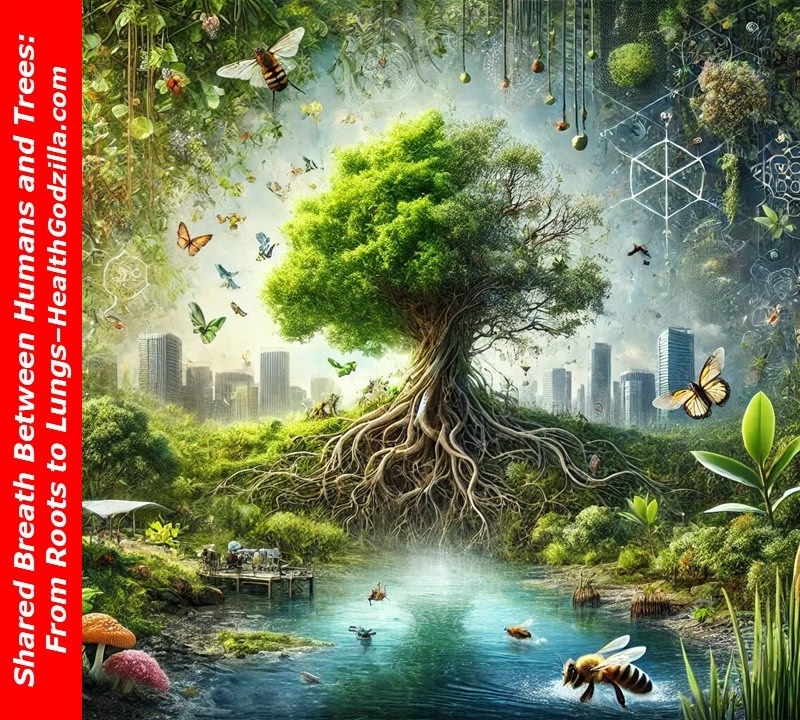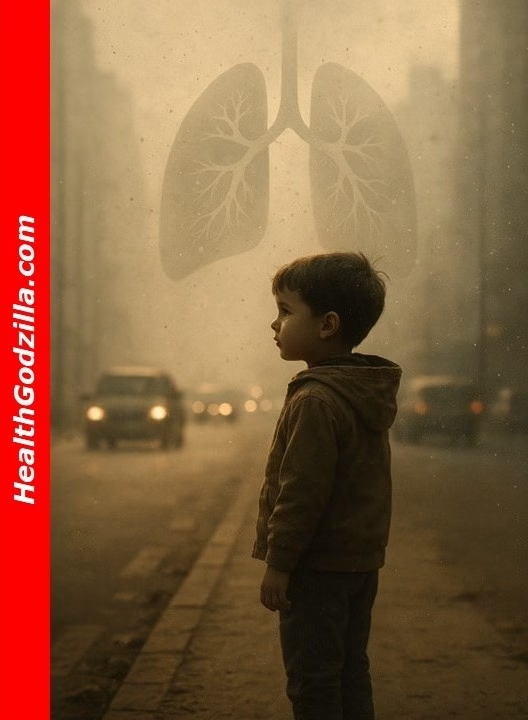
Shared Breath Between Humans and Trees begins not with noise, but with a hush. In the heart of any bustling city, where concrete and traffic prevail, a quieter story breathes beneath. Indeed, it’s the story of air and life—of invisible exchanges between lungs and leaves.
Trees, those silent sentinels, inhale the carbon we release. In return, they exhale oxygen, shaping microclimates and sheltering life. However, they are not immune to the challenges that surround them. Pollution, like a creeping mist, seeps into their bark and roots—and in turn weakens the very beings we lean on to purify the air.
Furthermore, every year, air pollution claims over seven million lives, as the World Health Organization warns. Cities, pulsing with traffic and industry, thus become hotspots—where lungs, leaves, and lichen alike begin to suffer. As urbanization surges forward, the shared breath between humans and trees faces new threats. Ultimately, what weakens one inevitably touches the other.
🌫️ Where the Air Turns Against Us
What does polluted air look like? Sometimes, it’s the skyline dimmed to gray. At other times, it’s the bitter sting of exhaust after rush hour. However, more often, it’s what we cannot see—fine particles drifting in silence, entering our bodies with every breath.
Each particle carries a story of combustion. For example, fossil fuels burn in engines. Factories release sulfur dioxide and nitrogen oxides. Open fires smolder organic matter into smoke. These pollutants do not disappear. Instead, they pass through lungs, reach the bloodstream, and even touch unborn lives in the womb. As a result, asthma rises, chronic bronchitis grows, and the heart, though unseen, begins to strain.
Air pollution has now crossed a critical threshold. In cities across the globe—including those in developing nations—the air quality index often slips into “unhealthy” zones. Kuala Lumpur is just one such example. Still, pollution does not stop at the city’s edge. Rural areas near industrial farms, highways, and mines breathe it too—disturbing the shared breath between humans and trees that once flowed unseen.
🌳 Trees Inhale What We Exhale
Where pollution rises, trees do not retreat; instead, they breathe in. With leaves stretched to the sky and roots anchored deep, they act as living filters. They absorb nitrogen dioxide, sulfur dioxide, and particulate matter—drawing toxins into bark and leaf.
In return, they offer oxygen. They help hold moisture in the air and shape cooler microclimates that soften the city’s heat. But this gift has its price. Trees in polluted air begin to carry the damage they try to heal—acid rain scars their foliage, alters soil chemistry, and weakens the roots beneath.
This relationship is not one-sided. Trees depend on clean air, just as we rely on them to clean it. When the balance tips, ecosystems begin to falter. Bioindicators—such as mosses, lichens, and sensitive fungi—respond first. Their quiet decline signals rising pollution and warns us of biodiversity under stress.
As we rely on trees to guard our lungs, these silent witnesses offer signs—etched in bark, root, and breath—a record of the shared breath between humans and trees, now strained by the air we shape.
🌾 When Ecosystems Lose Their Breath
Imagine an ecosystem—a wetland, forest, or grassland—as a living orchestra. Each species plays its part; together, they create harmony through balance. Yet this natural symphony begins to falter when pollution drifts in.
Airborne pollutants like nitrogen oxides (NOₓ) and sulfur dioxide (SO₂), which are released from vehicles and factories, settle on leaves, soil, and water. In doing so, they slowly reshape the ecosystem’s structure. When these gases meet moisture, they form acid rain. This reaction, in turn, alters soil chemistry, harms roots, and blocks plants from absorbing key nutrients. Over time, pollution weakens ecosystems, reducing their biodiversity and their ability to cope with stress, including climate extremes.
Beyond that, pollution disrupts more than individual plants or animals; it unravels entire ecological networks. In aquatic systems, nitrogen and phosphorus from agriculture travel by air. As a result, they spark algal blooms—what scientists call eutrophication. These blooms block sunlight and steal oxygen, ultimately suffocating fish and disrupting the food chain. When this balance breaks, birds, mammals, and even humans lose the resources they once depended on.
On land, trees and plants signal early warnings. For instance, bioindicators like lichens show visible damage before other signs appear. Their decline, therefore, helps scientists read the health of the whole system. Eventually, as pollution builds, recovery becomes harder. Ecosystems lose resilience. Essential services—such as water purification, carbon storage, and soil fertility—begin to fade.
And finally, as these natural buffers weaken, the consequences reach us. Flood risks grow. Air and water degrade. What falters in a forest echoes in a village. The web of life, if stretched too thin, cannot hold—and the shared breath between humans and trees becomes harder to sustain.

🫁 How the Air Unravels Health
Pollution does not end at the lungs. Rather, it continues—silently—through arteries, across neurons, and into the growing minds of children. Studies now show a connection between air pollution and a range of health issues, including cardiovascular disease, weakened immunity, and cognitive disruptions.
The risks grow sharper near busy roads and industrial zones. For instance, the Children’s Health Study, one of the largest of its kind, found that children in polluted areas are more likely to develop asthma, bronchitis, and respiratory conditions that persist into adulthood. Beyond the lungs, pollution affects memory, learning, and emotional stability.
One of the most harmful pollutants is particulate matter—especially PM2.5. Due to their size, these particles pass deep into the lungs and do not stop there. Instead, they enter the bloodstream, affecting the heart and accelerating diseases like atherosclerosis. As arteries stiffen, the risks of heart attack and stroke increase.
Even before birth, pollution’s reach is evident. Pregnant people exposed to high levels of PM2.5 are more likely to give birth to babies with low birth weights. Emerging research also suggests that long-term exposure may raise the risk of developmental conditions such as autism and ADHD.
In the end, the air holds more than breath—it holds outcomes.
🏠 Breathing Indoors: The Overlooked Risk
When we speak of air pollution, we often picture highways and smokestacks. Yet pollution thrives indoors too—especially where cooking fires burn close to the floor. Across much of the world, families still rely on solid fuels—wood, coal, and dried dung—for warmth and food. As a result, the smoke released fills kitchens and sleeping spaces, clinging to the air like an unseen weight. Those most exposed are often women and children, who spend the most time indoors.
According to the World Health Organization, more than four million people die each year from household air pollution. Among them, the youngest—children under five—are especially vulnerable. Their lungs are still forming. Their breath is still learning the world.
Often overlooked, indoor air quality is treated as a private issue. Even so, its consequences ripple outward. What happens in the hearth echoes in the atmosphere. In this way, the microenvironments we build within walls reflect and reshape the shared breath between humans and trees outside.
🌍 Stewards of the Shared Breath
In this story, nothing stands alone. The air, the trees, and we—each are part of one breathing system. What we exhale, trees absorb. What they release, we carry in our lungs. This shared breath binds our health to biodiversity, and our future to the resilience of ecosystems.
It is not only a story of crisis. It is a story of possibility. Where policies reduce emissions, where cities plant trees, where clean energy replaces smoke—health improves. In Southern California, efforts to clean the air led to fewer asthma cases among children. Such stories remind us: change is not abstract.
Still, the deeper reason to act lies in the interdependence itself. By protecting biodiversity, we protect the systems that quietly protect us. Parks, greenways, urban forests—these are not luxuries. They are lungs, stitched into the concrete.
To breathe well is not just to survive, but to belong—to a world that exhales when we do.
🌫️ A Breath We Cannot Take Alone
The air we breathe is not ours alone. It travels—from leaf to lung, from city edge to forest floor. Every breath carries memory. Every inhale is an inheritance shared with trees, grasses, mosses, and all things that root and rise.
To understand pollution is not just to measure particles. It is to witness how the breath between humans and trees can fray. How the lungs of a child and the bark of a birch may both show strain. How silence in a forest can mirror the hush inside us.
Nature does not warn. Nature does not warn. It responds. Shape shifts quietly. There is no protest—only presence, and a slow shift when something is lost.
This story has no conclusion. Only a vanishing note. The kind that echoes for a while before settling in the chest. Before the page stills. Before breath becomes sleep.
🍂 Hello, Artista

Artista:
Do you ever feel, Organum, that trees know more about patience than we ever will?
Organum:
Maybe. They don’t resist the wind—they just lean and listen.
And still, they filter the air without asking who exhaled what.
Artista:
Sometimes I wonder if we’re not just borrowing breath from them.
Not in some poetic way—truly, molecularly. My lungs and a fig tree’s leaf might have met in passing.
Organum:
They might meet again. Or not. Breath is shared, not stored.
It’s the one thing we use together that doesn’t diminish—until we forget it’s shared.
Artista:
You know, after reading this, I walked past a row of city trees and whispered,
“Thanks for letting me inhale your silence.”
Organum (chuckling):
And did they reply?
Artista:
Not in words. But I think they paused.
Organum:
That’s the reply.
✍️ Author’s Reflection
I was not alone when I wrote this. Others spoke, and I listened.
There was no manifesto in my hand, no call to arms. Only a question wrapped in mist:
What is a breath, if not a thread?
Between lungs and leaves. Silence and sound. What we know—and what we still owe to the sky.
This piece came not to declare truth, but to let it stretch its legs and walk beside the reader. Not ahead. Not behind. Just there—quietly. Like a tree at your back while you speak to someone you love.
Some things in life are too light to lift, too vast to carry.
Air is one.
Memory, perhaps, another.
And so we walk on—between forests and furnaces, between the green and the grey—holding, not conclusions, but continuations.
—Jamee
🌼 Articles You May Like
From metal minds to stardust thoughts—more journeys await:
- AOL-Time Warner failure: Merger, mindsets, and market myths. Explore culture clash, transient advantage, primacy, and antitrust risks.
- Biodiversity and nutrition: Reforming diets through agrobiodiversity. Policy, Traditional and Indigenous Foods, and Scientific Relevance.
Curated with stardust by Organum & Artista under a sky full of questions.
📚 Principal Sources
- Mabahwi, N. A., Leh, O. L. H., & Omar, D. (2014). Human Health and Well-being: Human Health Effect of Air Pollution. Faculty of Architecture, Planning & Surveying, Universiti Teknologi MARA, AicQoL2014 Kota Kinabalu, AMER International Conference on Quality of Life, The Pacific Sutera Hotel, Sutera Harbour, Kota Kinabalu, Sabah, Malaysia, January 4-5.
- National Institutes of Health, U.S. Department of Health and Human Services. (2020). Air Pollution and Your Health.
- World Health Organization & Secretariat of the Convention on Biological Diversity. (2015). Connecting Global Priorities: Biodiversity and Human Health. A State of Knowledge Review.

Leave a Reply